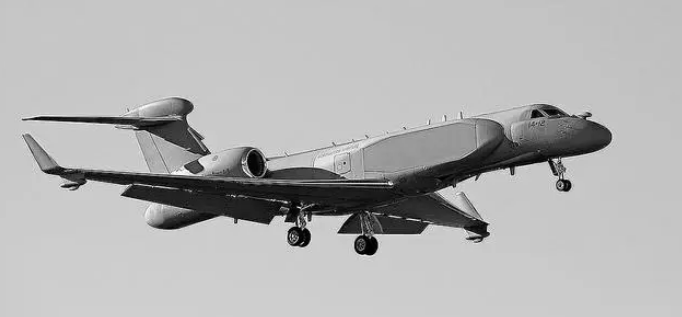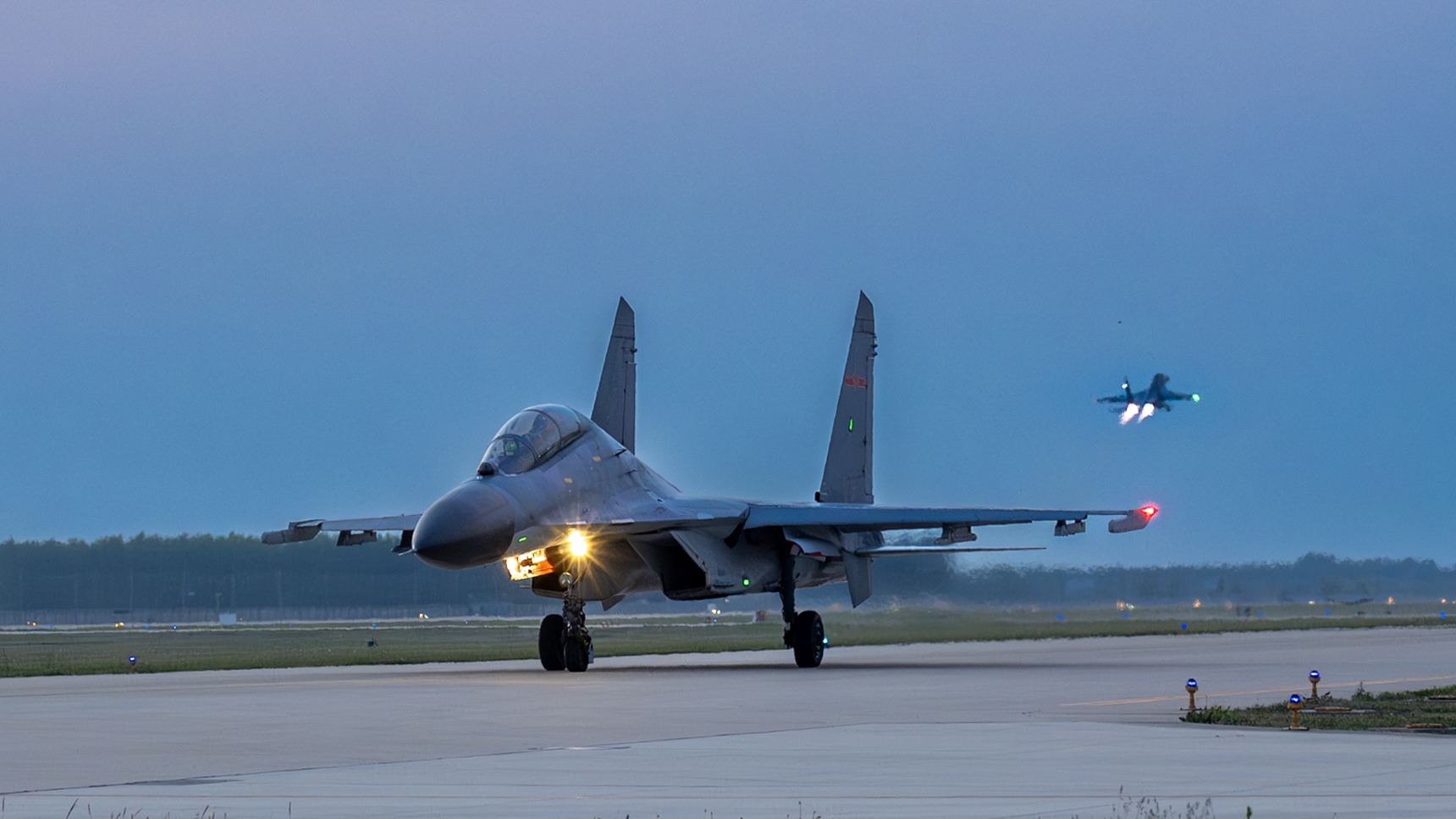By Qi Chengrong and Feng Liying
齐呈荣 冯丽滢

US EC-37B Compass Call electronic warfare aircraft (File photo)
美国EC-37B“罗盘呼叫”电子战飞机。资料照片
Recent media reports said that the ROK Defense Acquisition Program Administration (DAPA) voted through four bills including a basic strategic plan to develop electronic warfare aircraft. According to the bill, the country will launch the electronic warfare aircraft project in 2024, and its research and development are to be completed by 2032 as scheduled.
前段时间,有媒体报道,韩国防卫事业厅表决通过了该国《电子战飞机项目推进基本战略案》等4项议案。议案指出,韩国将于2024年启动电子战飞机项目,计划2032年完成研发。
Since the founding of the nation, ROK military enterprises have developed from scratch and made certain achievements, but the shadow of the US is also non-negligible. It is not difficult to see from the downgrade of KF-21 fighters from G5 to G4.5 that these enterprises are often stuck in a dilemma due to the lack of independent intellectual property rights and reliance on foreign core technologies.
自建国至今,韩国军工企业发展经历了从无到有,取得一定成绩。但不可忽视其背后笼罩着美国的阴影,机会主义色彩鲜明。从KF-21战机由五代机降级为四代半不难看出,缺乏自主知识产权、靠引进核心技术谋生的韩国军工企业,常常陷入“看人脸色”的现实窘境。
In the field of military industry, the development of advanced electronic warfare aircraft can be regarded as an overall test of a country's comprehensive aviation strength. From designing to technological verification, from synthetic materials to electronic systems, and from airframe platforms to instrument components, aircraft development may be held back by any weak point. For a country highly dependent on foreign technologies, bringing the new-type electronic warfare aircraft from concept to reality is a challenging journey that lies ahead.
在军工领域,先进电子战飞机的研制,是对一个国家航空综合实力的全面检验。从设计理念到技术论证,从合成材料到电子系统,从机体平台到仪表元件,无论哪个具体环节出现短板弱项,战机研发都会功亏一篑。对于高度依赖他国技术的韩国而言,想让新型电子战飞机从图纸飞向蓝天,前路漫长。
Accelerating aircraft development by "taking it": ROK sowed the seeds of disaster for the independent development of its aviation industry
奉行“拿来主义”提速研发,为航空工业自主发展埋下祸根
Looking back on the entire history of ROK's defense industry, its electronic warfare aircraft field is empty like a blank sheet of paper, indicating that independent development is a "building a skyscraper from none" challenge for their scientists and engineers.
回顾整个韩国国防工业历史,电子战飞机发展如同一张白纸,自主研制电子战飞机无疑是“沙地起高楼”,成为摆在韩国科研人员面前的一大难题。
Learning from electronic warfare aircraft unveiled in the past 50 years, the ROK R&D experts found that there are large fighters such as Tupolev Tu-154MD and Dassault Falcon 20, as well as smaller ones like EA-18G, F-16CJ, and Panavia Tornado ECR.
韩国科研人员从半个多世纪以来问世的电子战飞机“取经”——他们发现,在电子战飞机这个大家族中,不仅有图-154MD、“猎鹰20”这类大型战机,还有EA-18G、F-16CJ、“狂风”ECR等小型战机。
Therefore, there are two feasible options for ROK's independent development of electronic warfare aircraft: one is refitting jet airliners, similar to the US new generation of EC-37B Compass Call electronic warfare aircraft; the other is developing electronic warfare aircraft on the basis of small and medium-sized fighters.
不同的外形给韩国自主研制电子战飞机提供了两条路径:一条是以喷气式客机为平台进行改装,类似于美国新一代电子战飞机EC-37B“罗盘呼叫”;另一条则是以中小型战机为平台发展电子战飞机。
The ROK made a jaw-dropping decision to choose both despite a weak foundation, facilitating the development of electronic warfare aircraft by the joint efforts of the Korean Agency for Defense Development and military enterprises of the country. On the one hand, to ensure the long-endurance operational capability of new-type electronic warfare aircraft, it began to select jet airliners for refit, incorporating business aircraft such as Gulfstream G650, Bombardier Global 6500, and Dassault Falcon 2000 in the candidate model list for procurement. On the other hand, it plans to develop electronic attack aircraft on the platform of KF-21 fighters, which has not been approved by its Ministry of National Defense yet.
尽管基础薄弱,韩国却令人瞠目地做出了“二选二”的决定,由国防科学研究所和军工企业共同推进电子战飞机项目。一方面,为保证新型电子战飞机具有长航时作战能力,韩国开始遴选喷气式客机用作改装平台,将“湾流”G650、庞巴迪“环球”6500、达索“隼”2000等公务机纳入候选采购机型。另一方面,韩国准备以KF-21战机为平台研制电子攻击机,但该计划尚未得到韩国国防部批准。
The two development paths seem to be advancing steadily but are arduous and lengthy in practice. With its long-term reliance on the US and taking advantage of special geopolitical relations, Seoul’s aviation industry has obtained a lot of technical support from the US, but this kind of quick fix of “taking it” will not only put the country at the mercy of others for long, but also sow seeds of disaster for its independent development of the aviation industry.
两条发展路径,看似持续推进,实则道阻且长。韩国航空工业长期依赖美国,利用特殊地缘政治关系,背靠美国获得不少技术支持,但这种“拿来主义”的快捷方式,不仅会长期受制于人,还会为航空工业自主发展埋下祸根。
To exemplify with the instance of refitting small and medium-sized fighters, in the manufacturing process of KF-21 fighters, it takes 20 years for the country to barely reach the level of G4.5 due to heavy dependency on foreign technologies. As global military powers focus on G6 aircraft, the combat effectiveness of electronic warfare aircraft refitted from G4.5 fighters is still unknown.
以中小型战机为平台改装电子战飞机为例,在KF-21战机制造过程中,高度依赖他国技术,历经20年研发才勉强达到四代半水平。在世界军事强国重点发展六代机的大背景下,用四代半战机改装电子战飞机,其作战效能如何,还是一个未知数。
Development of homegrown fighter jets hampered at every turn: ROK lost self-reliance in national defense by relying on the US and Western nations.
发展国产战机处处掣肘,背靠美西方丧失自主国防
When the ROK was founded, it had a weak defense industry foundation and had to rely on technical support from other countries to establish a rudimentary system for firearm maintenance and upkeep. The turning point came in the 1970s. Driven by an export-oriented economic strategy, the ROK accelerated the implementation of an independent national defense policy with the help of its gradually improving economy and industrial infrastructure. Subsequently, it seized the critical period of US-Japan trade friction and rapidly built industrial facilities to boost economic development. In the field of electronics, the ROK leveraged the transfer of American industries to become a world leader in electronics industries such as smart phones, storage chips, and display screens.
建国初期,韩国国防工业基础薄弱,在他国的技术支持下,勉强建立起枪械维修和保养体系。转机来自20世纪70年代——在以出口为核心的外向型经济策略的推动下,韩国依托逐渐厚实的经济和工业基础,加速推行自主国防政策。随后,韩国把握美日贸易摩擦的关键时期,快速建设工业设施,提振经济发展。在电子产业领域,韩国借助美国产业转移,智能手机、存储芯片、显示屏等实体电子产业成功跻身世界前列。
However, the good times did not last long. The Asian financial crisis taught Seoul a harsh lesson. Since most of its large companies were expanding production through debt, when Western countries came to rip ROK off, its state-owned banks were on the brink of bankruptcy and major local enterprises fell into foreign hands. This resulted in a loss of autonomy, making both the electronic and aviation industries fall into stagnation. Four noteworthy reasons led to this.
不过,好景不长,亚洲金融危机爆发,给了韩国一个深刻教训——由于韩国大多数大型企业是举债扩大生产,当西方国家前来收割资本时,国有银行纷纷濒临破产,致使韩国主要企业落入他人之手,自主权近乎丧失,电子企业与航空工业发展陷入停滞。出现这一现象,存在4个不可忽视的问题。
The first is severe imbalance. The ROK electronics companies have focused too much on technologies such as storage and display panels, while semiconductor development has lagged. According to relevant data, its semiconductor inventory has approached KRW50 trillion due to continuous poor sales. In the aviation industry, whether its the original version of the KF-5E fighter jet or the F-16 fighter jet, ROK only received assembly licenses. This means that the aviation industry of the ROK is only capable of assembling and lacks research and development capabilities, let alone the capacity for independent development of weapon systems.
一是偏科严重。韩国电子企业过于注重存储和显示面板等技术,半导体发展相对滞后。有相关数据显示,由于销售持续低迷,韩国半导体库存总额已经逼近50万亿韩元。反观航空工业方面,无论是最初的韩国版KF-5E战机还是F-16战机,均只拿到了组装许可证,这意味着韩国航空工业只有制造能力,缺乏研发能力,并不具备武器装备自主发展实力。
The second is the lack of raw materials. The ROK has few mineral resources and relies on imports of major industrial raw materials, making it impossible to achieve self-sufficiency. This poses a significant constraint on the development of the aviation and electronic industries.
二是缺乏原料。韩国矿产资源较少,主要工业原料均依赖进口,原材料和设备无法实现自给自足,这对航空工业和电子产业发展造成很大制约。
The third is the lack of vitality. The ROK aviation and electronic industries have become excessively concentrated on well-known large enterprises, and issues under the conglomerate development model have become increasingly prominent after the economic crisis. Other small and medium-sized enterprises lack vitality and innovation abilities. As a result, they would quickly lose competitiveness when faced with external competition.
三是活力不足。韩国航空工业和电子产业发展过度集中于知名大型企业,经济危机爆发后,财阀发展模式下堆积问题不断凸显。其他中小型企业活力不足、创新乏力,一旦遇到外部竞争,很快丧失竞争力。
The fourth is the shortage of technology. Take the development of the KF-21 fighter jet as an example. ROK has to import high-performance aviation engines since the country is incapable to develop on its own. Seoul has revealed that it lacks dozens of key technologies required for the development of the KF-21 fighter jet. Although it successfully developed technologies such as active phased-array radar, electro-optical targeting pod, infrared search and track system, and infrared/radar jamming system with foreign technical support, the most critical stealth issue has never been resolved. The aviation industry of the ROK designed a non-stealth fighter jet with a stealthy appearance requiring external weapon pod through technical cooperation with Saab of Sweden. This obviously did not meet the standards of a fifth-generation fighter jet.
四是技术匮乏。以KF-21战机研制为例:由于韩国并不具备高性能航空发动机研发能力,发动机只能选择从国外进口。韩国曾透露,缺少KF-21战机研制所需的几十项关键技术。尽管有源相控阵雷达、光电瞄准吊舱、红外搜索与跟踪系统、红外/雷达干扰系统等在国外技术支持下研制成功,但最为关键的隐身问题始终未能解决。韩国航空工业通过与瑞典萨博公司开展技术合作,设计出一个具有隐身战机外形但需要武器外挂的非隐身战机方案,这显然未能达到五代机的标准。
In addition, although the ROK can manufacture electronic products such as phones and TVs, the operating environment for electronic warfare aircraft requires higher standards in terms of size, weight, and operational accuracy. This presents another significant challenge given its current strength in the electronic industry.
此外,虽然韩国能制造手机、电视等电子产品,但电子战飞机所需电子设备运行环境更严苛,对于体积、重量和运行精度要求更高,以韩国目前电子产业实力来看,这又是一道难关。
The seemingly impressive model development in the ROK actually relies on the mature technology and shelf products of its American and Western allies. When developing highly sophisticated equipment such as electronic warfare aircraft, the project is bound to face difficulties if external support is missing, or core technologies are constrained. This is a challenge faced by Seoul.
看似轰轰烈烈的型号开发,实则是依靠美西方盟友的成熟技术和货架产品支持。在研发电子战飞机这样高精尖装备时,一旦失去外援或关键核心技术受到制约,项目必然会推进不利,这也是韩国必须直面的难题。
Backstabbing allies for own interests: the US has its own selfish calculations
“背刺”盟友利益至上,美国打着自己的“小算盘”
In fact, possessing electronic warfare aircraft has long been a dream of the ROK. As early as 2019, a senior official of the country made it clear during his visit to the US that Seoul expected to purchase certain airborne avionics systems for intelligence, surveillance and reconnaissance (ISR). The main reason why it pinned its hope on the US lies in its KTX-2 Indigenous Trainer Program, which was launched with the aid of Lockheed Martin Space Systems Company (LMT), an American company. The prototype successfully made its maiden flight in 2002 and was named T-50 trainer (Golden Eagle), and has achieved good results in international military trade.
事实上,拥有电子战飞机是韩国长期以来的梦想。早在2019年,韩国一名高官在访美时就明确提出,希望采购一部分用于情报监视和侦察的机载航电系统。令韩国寄希望于美国的主要原因是其KTX-2超声速教练机计划,正是在美国洛马公司帮助下得以启动,原型机于2002年成功首飞,命名为T-50“金鹰”教练机,取得不错的国际军贸业绩。
However, the aim to purchase the airborne avionics system was ruthlessly rejected by the US. As the saying goes, "A country does not have permanent friends, only permanent interests." The development of electronic warfare aircraft involves many core technologies, and the US will not hand them on a silver platter.
没想到,采购机载航电系统遭到美国无情拒绝。正所谓“没有永远的朋友,只有永远的利益”,电子战飞机研制涉及诸多核心技术,美国不可能轻而易举地将其拱手相让。
In terms of the functionality of electronic warfare aircraft, it is not difficult to understand the rejection by the US – the advanced electronic warfare aircraft can provide theater commanders with out-of-defended-zone interference capability to cope with complex communication environments and enemy radar threats, as well as the ability to suppress enemy air defense networks and detect enemy aerial targets, which can add weight to ROK's pursuit of military independence. This just goes against the original intention of the US.
从电子战飞机的功能上,也不难理解美国作出的决定——一款先进的电子战飞机能够为战区指挥官提供防区外干扰能力,以应对复杂的通信环境和敌方雷达威胁,还拥有压制敌方防空网络、探测敌方空中目标的能力,可以为韩国谋求军事方面独立增加砝码。这与美国的初衷背道而驰。
Developing the electronic warfare aircraft is sure to enhance Seoul's military strength and to some extent weaken the US military control over it, which the US military is unwilling to accept. In addition, the independent development or manufacture of electronic warfare aircraft by the ROK will inevitably impact US' export of electronic warfare aircraft such as the EC-37B Compass Call from to its allies including Japan and Australia.
发展电子战飞机会增强韩国军事实力,一定程度上削弱美军对韩国军队的掌控力,这是美军不愿看到的结果。此外,韩国拥有自主研发或者可以自行生产电子战飞机,势必会对美国向日本、澳大利亚等盟国出口EC-37B“罗盘呼叫”这类电子战飞机造成影响。
Upholding the principle of self-interest first, US has backstabbed its allies from time to time. In 1978, Swedish defense company Saab signed an agreement with the Indian armed forces to sell Saab-37 Viggen (Thunderbolt) to India. In order to consolidate its military sales to India, the US chose to intervene and impose an embargo on the engines of the Saab-37 Viggen, which ultimately led to the collapse of the transaction.
利益至上是美国遵循的一贯法则,“背刺”盟友的例子也屡见不鲜。1978年,瑞典萨博公司与印度军方签订“雷”式战机采购协议。美国为了巩固对印军售市场,选择横插一手,对“雷”式战机发动机实施禁运,导致交易最终流产。
The ROK has similar experience as well. In 2001, Seoul planned to develop the KF-21 fighter, attempting to join the "Fifth-Generation Fighters Club" with the help of the US. However, its development encountered countless handicaps during the past two decades or so, and ROK had to put together a 4.5G fighter jet instead.
韩国也曾吃过大亏。2001年,韩国提出研制KF-21战机,企图通过美国的帮助,一举跨入“五代机俱乐部”。然而,KF-21战机研发被处处掣肘,至今已耗时20余年,最终只能无奈降级为四代半。
Undoubtedly, the US is the mastermind behind this outcome. In order to prevent Seoul from developing advanced fighter jets comparable to its F-35, the US rigorously reviewed the list of 25 core technologies proposed by the ROK side, and even demanded the ROK stop the KF-21 project. Although the US government has ultimately approved the transfer of 21 jet technologies used in Lockheed Martin's F-35 stealth fighter after great efforts made by the ROK government, the US denied the transfer of any core technologies of great concern, no matter how hard Seoul tried to work on it.
毫无疑问,造成这种结果,美国是幕后黑手。为了防止韩国研制出比肩F-35的先进战机,美国对韩国提出的包括25项核心技术在内的清单进行严格审查,甚至一度要求韩国停止KF-21项目。经过韩国政府一番努力,美国最终同意洛马公司转让21项技术,但在至关重要的核心技术上,无论韩国怎么“做工作”,美国仍然说“不”。
As things stand, Seoul has resolutely decided to develop electronic warfare aircraft, despite its ambition being in a conceptual stage. There are still many uncertainties to deal with to fly the aircraft out of blueprint, not to mention forming combat capability.
就目前看,韩国研制电子战飞机的决心很大,但依然停留在设想阶段,未来能否从图纸飞向天空,真正形成战斗力,还有很多不确定因素。
Despite KF-21 downgrading and multiple obstacles in developing electronic warfare aircraft, it is still difficult for the ROK to completely get rid of the US in terms of weapons and equipment development. It is safe to say that there is still a long way to go for the ROK to achieve independence in national defense.
不论是KF-21惨遭降级,还是电子战飞机研发被处处掣肘,韩国武器装备与美国彻底“脱钩”有点难。可以说,韩国要想实现自主国防,需要挣脱的羁绊还有很多。









